Reducing Imprisonment Rate of Aboriginals and Torres Strait Islander People
VerifiedAdded on 2023/03/30
|11
|2509
|498
AI Summary
This report examines the overrepresentation of Aboriginals and Torres Strait Islander people in prisons and provides recommendations for reducing their imprisonment rate. It discusses the exclusion of prisoners from the National Disability Insurance Scheme (NDIS) and the violation of their basic health care rights. The report also highlights the need for amendments to the Health Insurance Act (1973) and calls for a harm reduction approach in the policy. The implementation of these recommendations will lead to improved health, social, and economic outcomes for Aboriginals and Torres Strait Islander people.
Contribute Materials
Your contribution can guide someone’s learning journey. Share your
documents today.
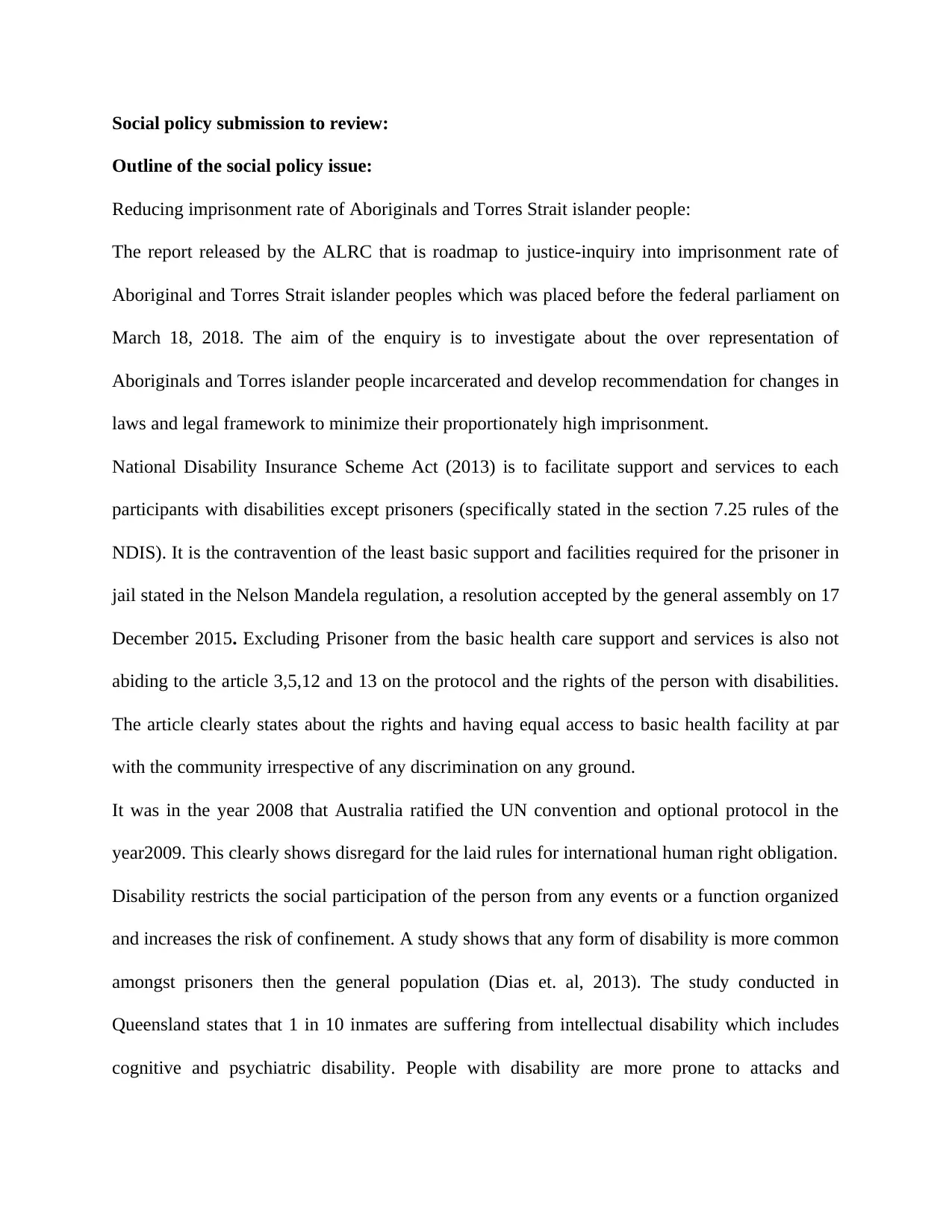
Social policy submission to review:
Outline of the social policy issue:
Reducing imprisonment rate of Aboriginals and Torres Strait islander people:
The report released by the ALRC that is roadmap to justice-inquiry into imprisonment rate of
Aboriginal and Torres Strait islander peoples which was placed before the federal parliament on
March 18, 2018. The aim of the enquiry is to investigate about the over representation of
Aboriginals and Torres islander people incarcerated and develop recommendation for changes in
laws and legal framework to minimize their proportionately high imprisonment.
National Disability Insurance Scheme Act (2013) is to facilitate support and services to each
participants with disabilities except prisoners (specifically stated in the section 7.25 rules of the
NDIS). It is the contravention of the least basic support and facilities required for the prisoner in
jail stated in the Nelson Mandela regulation, a resolution accepted by the general assembly on 17
December 2015. Excluding Prisoner from the basic health care support and services is also not
abiding to the article 3,5,12 and 13 on the protocol and the rights of the person with disabilities.
The article clearly states about the rights and having equal access to basic health facility at par
with the community irrespective of any discrimination on any ground.
It was in the year 2008 that Australia ratified the UN convention and optional protocol in the
year2009. This clearly shows disregard for the laid rules for international human right obligation.
Disability restricts the social participation of the person from any events or a function organized
and increases the risk of confinement. A study shows that any form of disability is more common
amongst prisoners then the general population (Dias et. al, 2013). The study conducted in
Queensland states that 1 in 10 inmates are suffering from intellectual disability which includes
cognitive and psychiatric disability. People with disability are more prone to attacks and
Outline of the social policy issue:
Reducing imprisonment rate of Aboriginals and Torres Strait islander people:
The report released by the ALRC that is roadmap to justice-inquiry into imprisonment rate of
Aboriginal and Torres Strait islander peoples which was placed before the federal parliament on
March 18, 2018. The aim of the enquiry is to investigate about the over representation of
Aboriginals and Torres islander people incarcerated and develop recommendation for changes in
laws and legal framework to minimize their proportionately high imprisonment.
National Disability Insurance Scheme Act (2013) is to facilitate support and services to each
participants with disabilities except prisoners (specifically stated in the section 7.25 rules of the
NDIS). It is the contravention of the least basic support and facilities required for the prisoner in
jail stated in the Nelson Mandela regulation, a resolution accepted by the general assembly on 17
December 2015. Excluding Prisoner from the basic health care support and services is also not
abiding to the article 3,5,12 and 13 on the protocol and the rights of the person with disabilities.
The article clearly states about the rights and having equal access to basic health facility at par
with the community irrespective of any discrimination on any ground.
It was in the year 2008 that Australia ratified the UN convention and optional protocol in the
year2009. This clearly shows disregard for the laid rules for international human right obligation.
Disability restricts the social participation of the person from any events or a function organized
and increases the risk of confinement. A study shows that any form of disability is more common
amongst prisoners then the general population (Dias et. al, 2013). The study conducted in
Queensland states that 1 in 10 inmates are suffering from intellectual disability which includes
cognitive and psychiatric disability. People with disability are more prone to attacks and
Secure Best Marks with AI Grader
Need help grading? Try our AI Grader for instant feedback on your assignments.
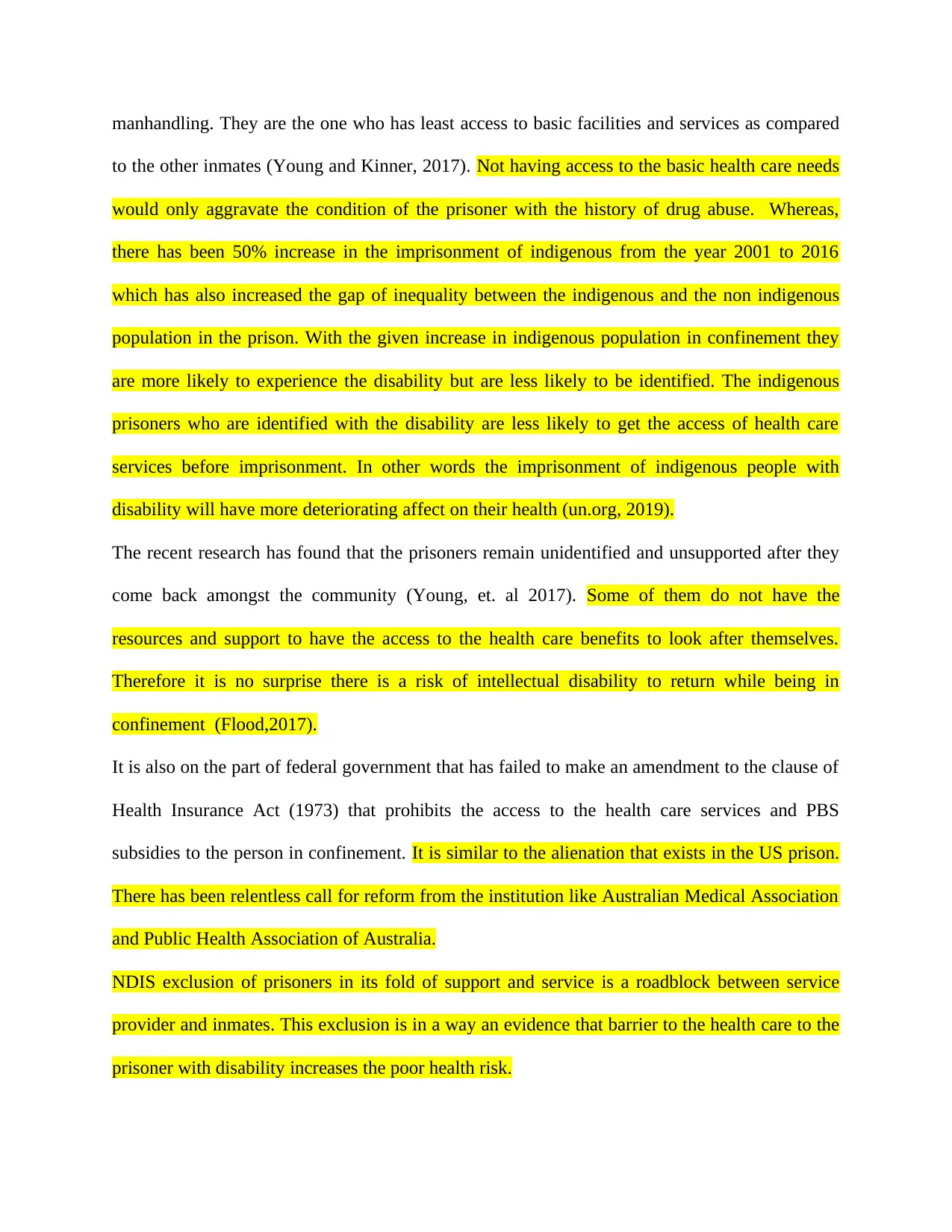
manhandling. They are the one who has least access to basic facilities and services as compared
to the other inmates (Young and Kinner, 2017). Not having access to the basic health care needs
would only aggravate the condition of the prisoner with the history of drug abuse. Whereas,
there has been 50% increase in the imprisonment of indigenous from the year 2001 to 2016
which has also increased the gap of inequality between the indigenous and the non indigenous
population in the prison. With the given increase in indigenous population in confinement they
are more likely to experience the disability but are less likely to be identified. The indigenous
prisoners who are identified with the disability are less likely to get the access of health care
services before imprisonment. In other words the imprisonment of indigenous people with
disability will have more deteriorating affect on their health (un.org, 2019).
The recent research has found that the prisoners remain unidentified and unsupported after they
come back amongst the community (Young, et. al 2017). Some of them do not have the
resources and support to have the access to the health care benefits to look after themselves.
Therefore it is no surprise there is a risk of intellectual disability to return while being in
confinement (Flood,2017).
It is also on the part of federal government that has failed to make an amendment to the clause of
Health Insurance Act (1973) that prohibits the access to the health care services and PBS
subsidies to the person in confinement. It is similar to the alienation that exists in the US prison.
There has been relentless call for reform from the institution like Australian Medical Association
and Public Health Association of Australia.
NDIS exclusion of prisoners in its fold of support and service is a roadblock between service
provider and inmates. This exclusion is in a way an evidence that barrier to the health care to the
prisoner with disability increases the poor health risk.
to the other inmates (Young and Kinner, 2017). Not having access to the basic health care needs
would only aggravate the condition of the prisoner with the history of drug abuse. Whereas,
there has been 50% increase in the imprisonment of indigenous from the year 2001 to 2016
which has also increased the gap of inequality between the indigenous and the non indigenous
population in the prison. With the given increase in indigenous population in confinement they
are more likely to experience the disability but are less likely to be identified. The indigenous
prisoners who are identified with the disability are less likely to get the access of health care
services before imprisonment. In other words the imprisonment of indigenous people with
disability will have more deteriorating affect on their health (un.org, 2019).
The recent research has found that the prisoners remain unidentified and unsupported after they
come back amongst the community (Young, et. al 2017). Some of them do not have the
resources and support to have the access to the health care benefits to look after themselves.
Therefore it is no surprise there is a risk of intellectual disability to return while being in
confinement (Flood,2017).
It is also on the part of federal government that has failed to make an amendment to the clause of
Health Insurance Act (1973) that prohibits the access to the health care services and PBS
subsidies to the person in confinement. It is similar to the alienation that exists in the US prison.
There has been relentless call for reform from the institution like Australian Medical Association
and Public Health Association of Australia.
NDIS exclusion of prisoners in its fold of support and service is a roadblock between service
provider and inmates. This exclusion is in a way an evidence that barrier to the health care to the
prisoner with disability increases the poor health risk.
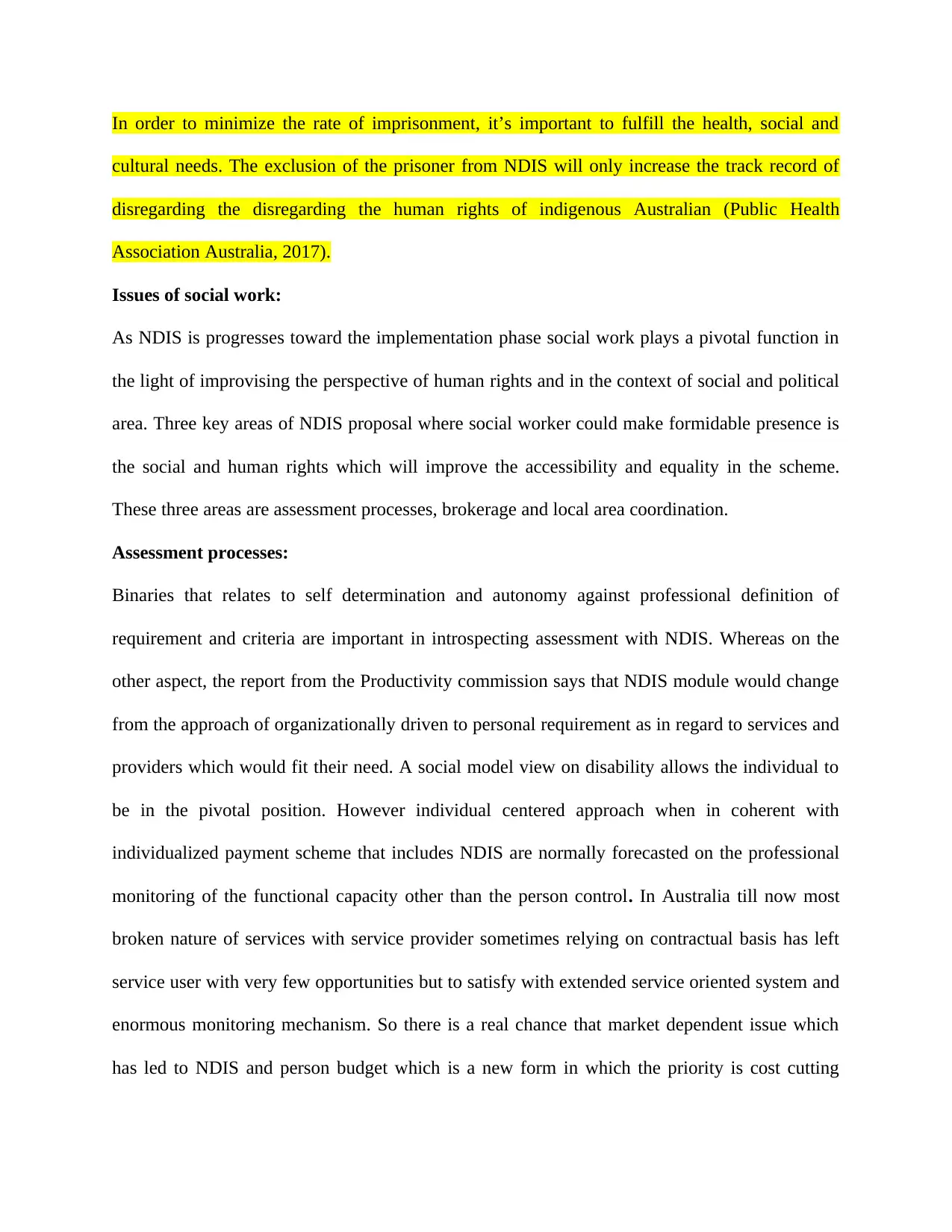
In order to minimize the rate of imprisonment, it’s important to fulfill the health, social and
cultural needs. The exclusion of the prisoner from NDIS will only increase the track record of
disregarding the disregarding the human rights of indigenous Australian (Public Health
Association Australia, 2017).
Issues of social work:
As NDIS is progresses toward the implementation phase social work plays a pivotal function in
the light of improvising the perspective of human rights and in the context of social and political
area. Three key areas of NDIS proposal where social worker could make formidable presence is
the social and human rights which will improve the accessibility and equality in the scheme.
These three areas are assessment processes, brokerage and local area coordination.
Assessment processes:
Binaries that relates to self determination and autonomy against professional definition of
requirement and criteria are important in introspecting assessment with NDIS. Whereas on the
other aspect, the report from the Productivity commission says that NDIS module would change
from the approach of organizationally driven to personal requirement as in regard to services and
providers which would fit their need. A social model view on disability allows the individual to
be in the pivotal position. However individual centered approach when in coherent with
individualized payment scheme that includes NDIS are normally forecasted on the professional
monitoring of the functional capacity other than the person control. In Australia till now most
broken nature of services with service provider sometimes relying on contractual basis has left
service user with very few opportunities but to satisfy with extended service oriented system and
enormous monitoring mechanism. So there is a real chance that market dependent issue which
has led to NDIS and person budget which is a new form in which the priority is cost cutting
cultural needs. The exclusion of the prisoner from NDIS will only increase the track record of
disregarding the disregarding the human rights of indigenous Australian (Public Health
Association Australia, 2017).
Issues of social work:
As NDIS is progresses toward the implementation phase social work plays a pivotal function in
the light of improvising the perspective of human rights and in the context of social and political
area. Three key areas of NDIS proposal where social worker could make formidable presence is
the social and human rights which will improve the accessibility and equality in the scheme.
These three areas are assessment processes, brokerage and local area coordination.
Assessment processes:
Binaries that relates to self determination and autonomy against professional definition of
requirement and criteria are important in introspecting assessment with NDIS. Whereas on the
other aspect, the report from the Productivity commission says that NDIS module would change
from the approach of organizationally driven to personal requirement as in regard to services and
providers which would fit their need. A social model view on disability allows the individual to
be in the pivotal position. However individual centered approach when in coherent with
individualized payment scheme that includes NDIS are normally forecasted on the professional
monitoring of the functional capacity other than the person control. In Australia till now most
broken nature of services with service provider sometimes relying on contractual basis has left
service user with very few opportunities but to satisfy with extended service oriented system and
enormous monitoring mechanism. So there is a real chance that market dependent issue which
has led to NDIS and person budget which is a new form in which the priority is cost cutting
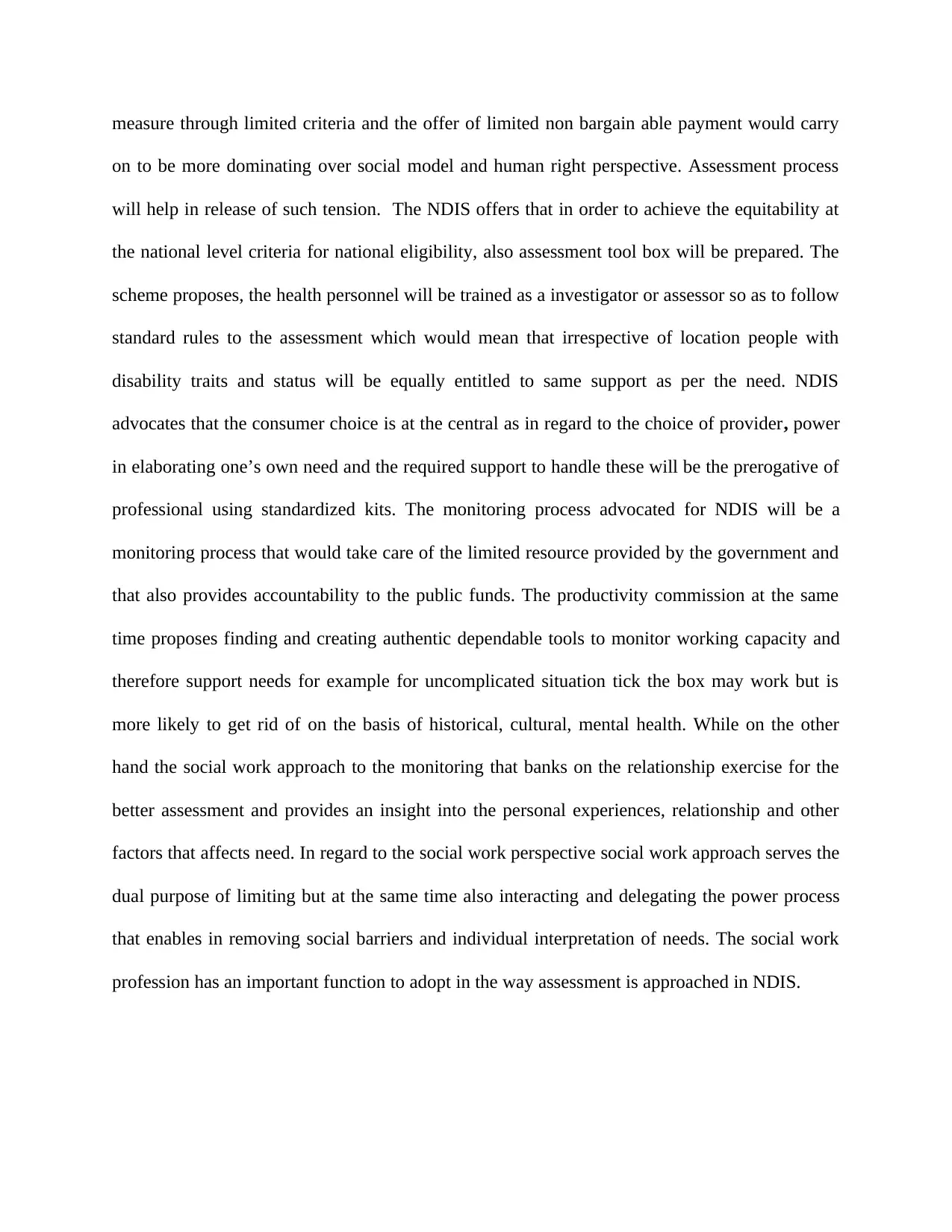
measure through limited criteria and the offer of limited non bargain able payment would carry
on to be more dominating over social model and human right perspective. Assessment process
will help in release of such tension. The NDIS offers that in order to achieve the equitability at
the national level criteria for national eligibility, also assessment tool box will be prepared. The
scheme proposes, the health personnel will be trained as a investigator or assessor so as to follow
standard rules to the assessment which would mean that irrespective of location people with
disability traits and status will be equally entitled to same support as per the need. NDIS
advocates that the consumer choice is at the central as in regard to the choice of provider, power
in elaborating one’s own need and the required support to handle these will be the prerogative of
professional using standardized kits. The monitoring process advocated for NDIS will be a
monitoring process that would take care of the limited resource provided by the government and
that also provides accountability to the public funds. The productivity commission at the same
time proposes finding and creating authentic dependable tools to monitor working capacity and
therefore support needs for example for uncomplicated situation tick the box may work but is
more likely to get rid of on the basis of historical, cultural, mental health. While on the other
hand the social work approach to the monitoring that banks on the relationship exercise for the
better assessment and provides an insight into the personal experiences, relationship and other
factors that affects need. In regard to the social work perspective social work approach serves the
dual purpose of limiting but at the same time also interacting and delegating the power process
that enables in removing social barriers and individual interpretation of needs. The social work
profession has an important function to adopt in the way assessment is approached in NDIS.
on to be more dominating over social model and human right perspective. Assessment process
will help in release of such tension. The NDIS offers that in order to achieve the equitability at
the national level criteria for national eligibility, also assessment tool box will be prepared. The
scheme proposes, the health personnel will be trained as a investigator or assessor so as to follow
standard rules to the assessment which would mean that irrespective of location people with
disability traits and status will be equally entitled to same support as per the need. NDIS
advocates that the consumer choice is at the central as in regard to the choice of provider, power
in elaborating one’s own need and the required support to handle these will be the prerogative of
professional using standardized kits. The monitoring process advocated for NDIS will be a
monitoring process that would take care of the limited resource provided by the government and
that also provides accountability to the public funds. The productivity commission at the same
time proposes finding and creating authentic dependable tools to monitor working capacity and
therefore support needs for example for uncomplicated situation tick the box may work but is
more likely to get rid of on the basis of historical, cultural, mental health. While on the other
hand the social work approach to the monitoring that banks on the relationship exercise for the
better assessment and provides an insight into the personal experiences, relationship and other
factors that affects need. In regard to the social work perspective social work approach serves the
dual purpose of limiting but at the same time also interacting and delegating the power process
that enables in removing social barriers and individual interpretation of needs. The social work
profession has an important function to adopt in the way assessment is approached in NDIS.
Secure Best Marks with AI Grader
Need help grading? Try our AI Grader for instant feedback on your assignments.
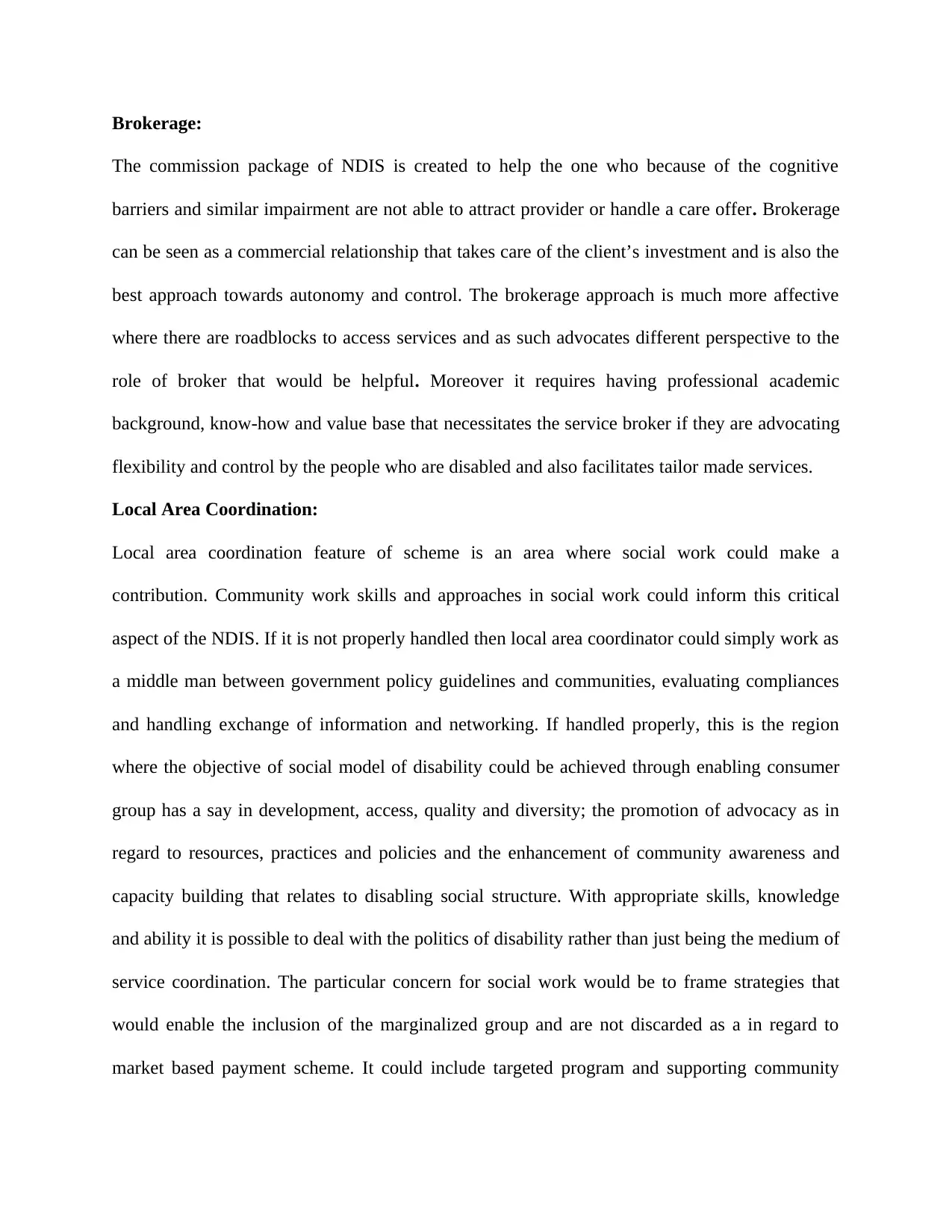
Brokerage:
The commission package of NDIS is created to help the one who because of the cognitive
barriers and similar impairment are not able to attract provider or handle a care offer. Brokerage
can be seen as a commercial relationship that takes care of the client’s investment and is also the
best approach towards autonomy and control. The brokerage approach is much more affective
where there are roadblocks to access services and as such advocates different perspective to the
role of broker that would be helpful. Moreover it requires having professional academic
background, know-how and value base that necessitates the service broker if they are advocating
flexibility and control by the people who are disabled and also facilitates tailor made services.
Local Area Coordination:
Local area coordination feature of scheme is an area where social work could make a
contribution. Community work skills and approaches in social work could inform this critical
aspect of the NDIS. If it is not properly handled then local area coordinator could simply work as
a middle man between government policy guidelines and communities, evaluating compliances
and handling exchange of information and networking. If handled properly, this is the region
where the objective of social model of disability could be achieved through enabling consumer
group has a say in development, access, quality and diversity; the promotion of advocacy as in
regard to resources, practices and policies and the enhancement of community awareness and
capacity building that relates to disabling social structure. With appropriate skills, knowledge
and ability it is possible to deal with the politics of disability rather than just being the medium of
service coordination. The particular concern for social work would be to frame strategies that
would enable the inclusion of the marginalized group and are not discarded as a in regard to
market based payment scheme. It could include targeted program and supporting community
The commission package of NDIS is created to help the one who because of the cognitive
barriers and similar impairment are not able to attract provider or handle a care offer. Brokerage
can be seen as a commercial relationship that takes care of the client’s investment and is also the
best approach towards autonomy and control. The brokerage approach is much more affective
where there are roadblocks to access services and as such advocates different perspective to the
role of broker that would be helpful. Moreover it requires having professional academic
background, know-how and value base that necessitates the service broker if they are advocating
flexibility and control by the people who are disabled and also facilitates tailor made services.
Local Area Coordination:
Local area coordination feature of scheme is an area where social work could make a
contribution. Community work skills and approaches in social work could inform this critical
aspect of the NDIS. If it is not properly handled then local area coordinator could simply work as
a middle man between government policy guidelines and communities, evaluating compliances
and handling exchange of information and networking. If handled properly, this is the region
where the objective of social model of disability could be achieved through enabling consumer
group has a say in development, access, quality and diversity; the promotion of advocacy as in
regard to resources, practices and policies and the enhancement of community awareness and
capacity building that relates to disabling social structure. With appropriate skills, knowledge
and ability it is possible to deal with the politics of disability rather than just being the medium of
service coordination. The particular concern for social work would be to frame strategies that
would enable the inclusion of the marginalized group and are not discarded as a in regard to
market based payment scheme. It could include targeted program and supporting community
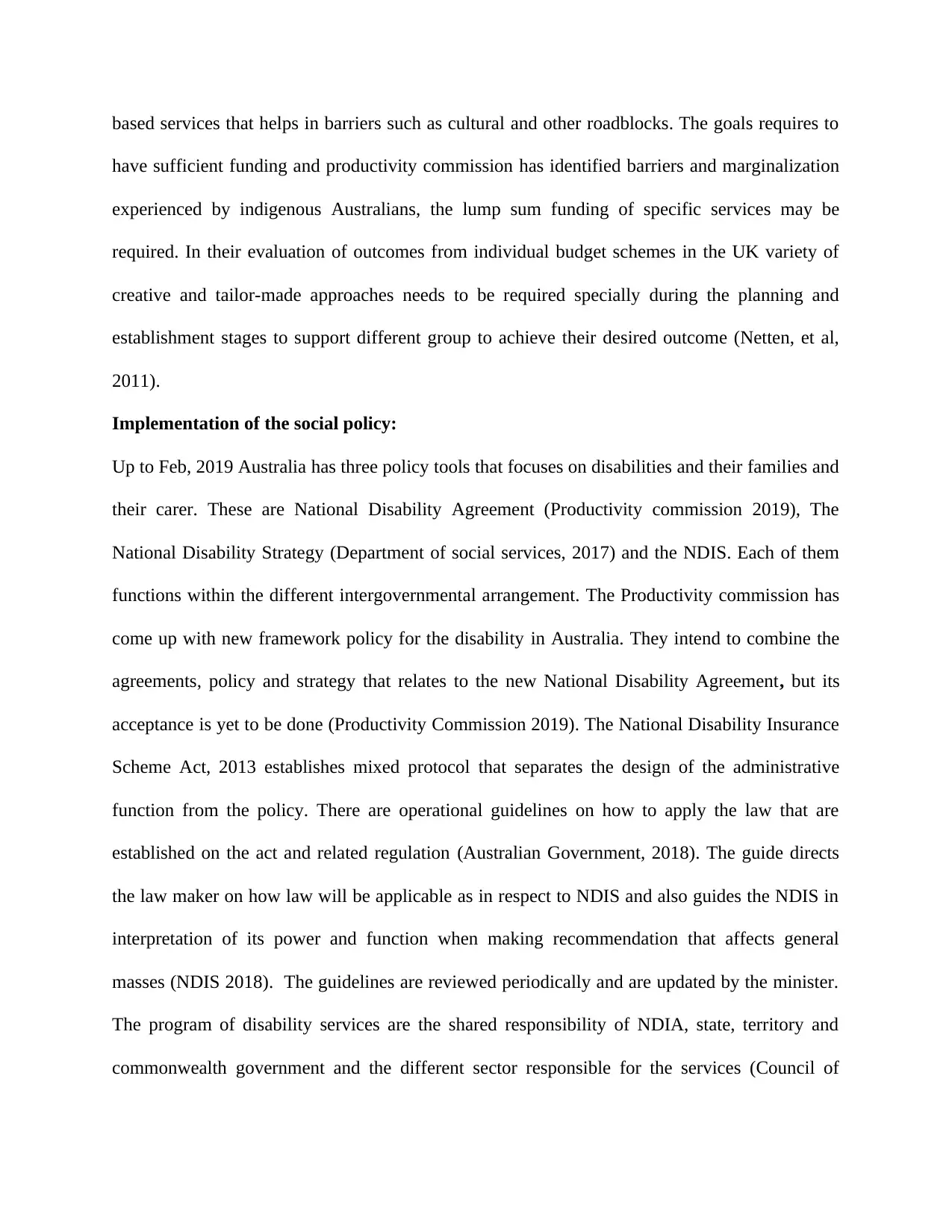
based services that helps in barriers such as cultural and other roadblocks. The goals requires to
have sufficient funding and productivity commission has identified barriers and marginalization
experienced by indigenous Australians, the lump sum funding of specific services may be
required. In their evaluation of outcomes from individual budget schemes in the UK variety of
creative and tailor-made approaches needs to be required specially during the planning and
establishment stages to support different group to achieve their desired outcome (Netten, et al,
2011).
Implementation of the social policy:
Up to Feb, 2019 Australia has three policy tools that focuses on disabilities and their families and
their carer. These are National Disability Agreement (Productivity commission 2019), The
National Disability Strategy (Department of social services, 2017) and the NDIS. Each of them
functions within the different intergovernmental arrangement. The Productivity commission has
come up with new framework policy for the disability in Australia. They intend to combine the
agreements, policy and strategy that relates to the new National Disability Agreement, but its
acceptance is yet to be done (Productivity Commission 2019). The National Disability Insurance
Scheme Act, 2013 establishes mixed protocol that separates the design of the administrative
function from the policy. There are operational guidelines on how to apply the law that are
established on the act and related regulation (Australian Government, 2018). The guide directs
the law maker on how law will be applicable as in respect to NDIS and also guides the NDIS in
interpretation of its power and function when making recommendation that affects general
masses (NDIS 2018). The guidelines are reviewed periodically and are updated by the minister.
The program of disability services are the shared responsibility of NDIA, state, territory and
commonwealth government and the different sector responsible for the services (Council of
have sufficient funding and productivity commission has identified barriers and marginalization
experienced by indigenous Australians, the lump sum funding of specific services may be
required. In their evaluation of outcomes from individual budget schemes in the UK variety of
creative and tailor-made approaches needs to be required specially during the planning and
establishment stages to support different group to achieve their desired outcome (Netten, et al,
2011).
Implementation of the social policy:
Up to Feb, 2019 Australia has three policy tools that focuses on disabilities and their families and
their carer. These are National Disability Agreement (Productivity commission 2019), The
National Disability Strategy (Department of social services, 2017) and the NDIS. Each of them
functions within the different intergovernmental arrangement. The Productivity commission has
come up with new framework policy for the disability in Australia. They intend to combine the
agreements, policy and strategy that relates to the new National Disability Agreement, but its
acceptance is yet to be done (Productivity Commission 2019). The National Disability Insurance
Scheme Act, 2013 establishes mixed protocol that separates the design of the administrative
function from the policy. There are operational guidelines on how to apply the law that are
established on the act and related regulation (Australian Government, 2018). The guide directs
the law maker on how law will be applicable as in respect to NDIS and also guides the NDIS in
interpretation of its power and function when making recommendation that affects general
masses (NDIS 2018). The guidelines are reviewed periodically and are updated by the minister.
The program of disability services are the shared responsibility of NDIA, state, territory and
commonwealth government and the different sector responsible for the services (Council of
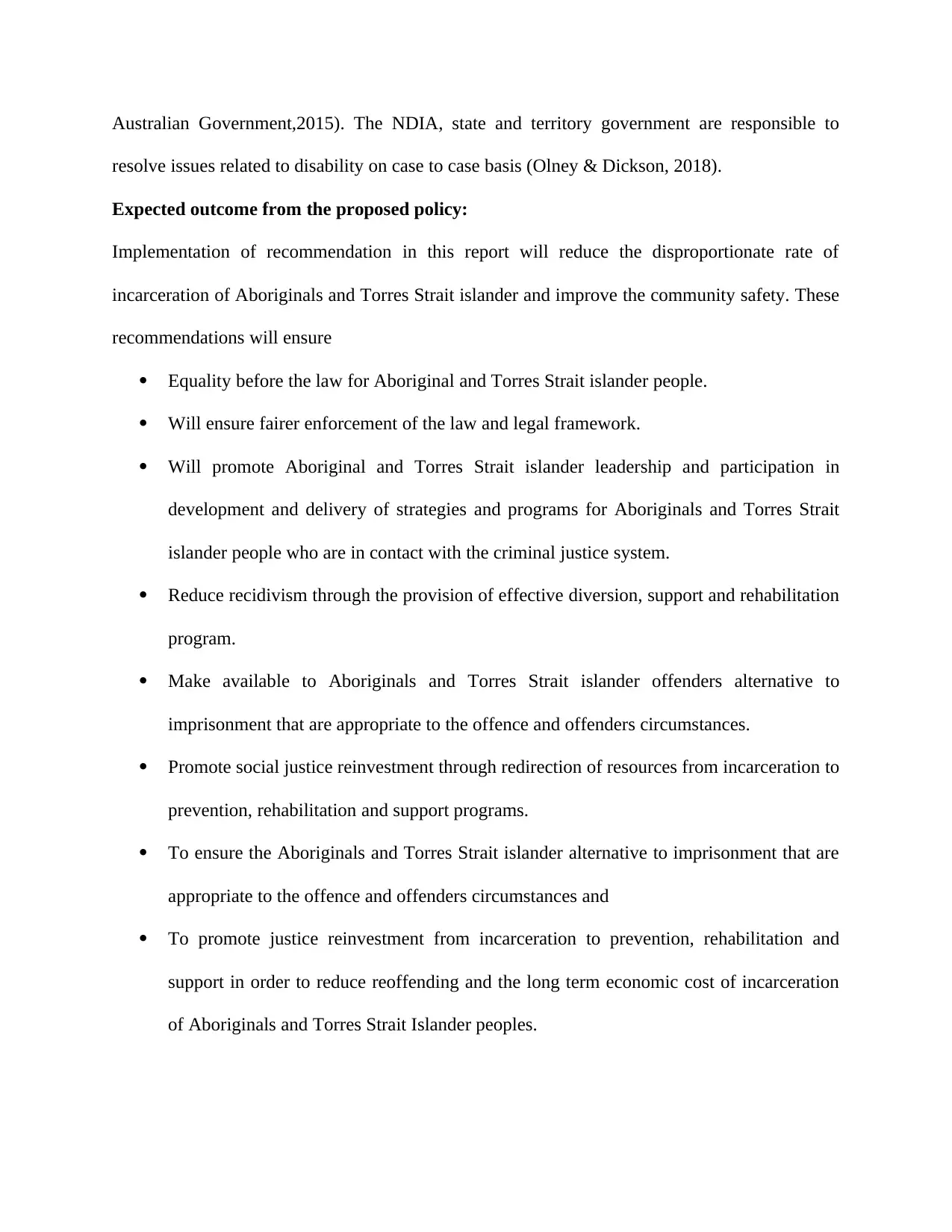
Australian Government,2015). The NDIA, state and territory government are responsible to
resolve issues related to disability on case to case basis (Olney & Dickson, 2018).
Expected outcome from the proposed policy:
Implementation of recommendation in this report will reduce the disproportionate rate of
incarceration of Aboriginals and Torres Strait islander and improve the community safety. These
recommendations will ensure
Equality before the law for Aboriginal and Torres Strait islander people.
Will ensure fairer enforcement of the law and legal framework.
Will promote Aboriginal and Torres Strait islander leadership and participation in
development and delivery of strategies and programs for Aboriginals and Torres Strait
islander people who are in contact with the criminal justice system.
Reduce recidivism through the provision of effective diversion, support and rehabilitation
program.
Make available to Aboriginals and Torres Strait islander offenders alternative to
imprisonment that are appropriate to the offence and offenders circumstances.
Promote social justice reinvestment through redirection of resources from incarceration to
prevention, rehabilitation and support programs.
To ensure the Aboriginals and Torres Strait islander alternative to imprisonment that are
appropriate to the offence and offenders circumstances and
To promote justice reinvestment from incarceration to prevention, rehabilitation and
support in order to reduce reoffending and the long term economic cost of incarceration
of Aboriginals and Torres Strait Islander peoples.
resolve issues related to disability on case to case basis (Olney & Dickson, 2018).
Expected outcome from the proposed policy:
Implementation of recommendation in this report will reduce the disproportionate rate of
incarceration of Aboriginals and Torres Strait islander and improve the community safety. These
recommendations will ensure
Equality before the law for Aboriginal and Torres Strait islander people.
Will ensure fairer enforcement of the law and legal framework.
Will promote Aboriginal and Torres Strait islander leadership and participation in
development and delivery of strategies and programs for Aboriginals and Torres Strait
islander people who are in contact with the criminal justice system.
Reduce recidivism through the provision of effective diversion, support and rehabilitation
program.
Make available to Aboriginals and Torres Strait islander offenders alternative to
imprisonment that are appropriate to the offence and offenders circumstances.
Promote social justice reinvestment through redirection of resources from incarceration to
prevention, rehabilitation and support programs.
To ensure the Aboriginals and Torres Strait islander alternative to imprisonment that are
appropriate to the offence and offenders circumstances and
To promote justice reinvestment from incarceration to prevention, rehabilitation and
support in order to reduce reoffending and the long term economic cost of incarceration
of Aboriginals and Torres Strait Islander peoples.
Paraphrase This Document
Need a fresh take? Get an instant paraphrase of this document with our AI Paraphraser

Reduced imprisonment and greater support for Aboriginal and Torres Strait Islander with
criminal justice system will in turn improve health, social and economic outcome for Aboriginal
and Torres Strait islander people (Community College Australia, 2018).
Key recommendation:
The number of representation of Aboriginals and Torres Islander should be reduced with
the steps taken by the Council of Australian government.
NDIS should bring reform in its policy to abide by the Mandela rules of UN convention.
To decrease the gap of inadequate health access by the indigenous as compared to the
non indigenous prisoner.
To make an amendment in the clause of Health Insurance Act (1973) that may allow the
access of health support and PBS in Australia.
A harm reduction approach to be included in the policy.
Common wealth government ensures the minimum standard of health and well being of
the prisoner.
A harm minimization approach to be included in health policy, services and standard
correctional set up.
criminal justice system will in turn improve health, social and economic outcome for Aboriginal
and Torres Strait islander people (Community College Australia, 2018).
Key recommendation:
The number of representation of Aboriginals and Torres Islander should be reduced with
the steps taken by the Council of Australian government.
NDIS should bring reform in its policy to abide by the Mandela rules of UN convention.
To decrease the gap of inadequate health access by the indigenous as compared to the
non indigenous prisoner.
To make an amendment in the clause of Health Insurance Act (1973) that may allow the
access of health support and PBS in Australia.
A harm reduction approach to be included in the policy.
Common wealth government ensures the minimum standard of health and well being of
the prisoner.
A harm minimization approach to be included in health policy, services and standard
correctional set up.
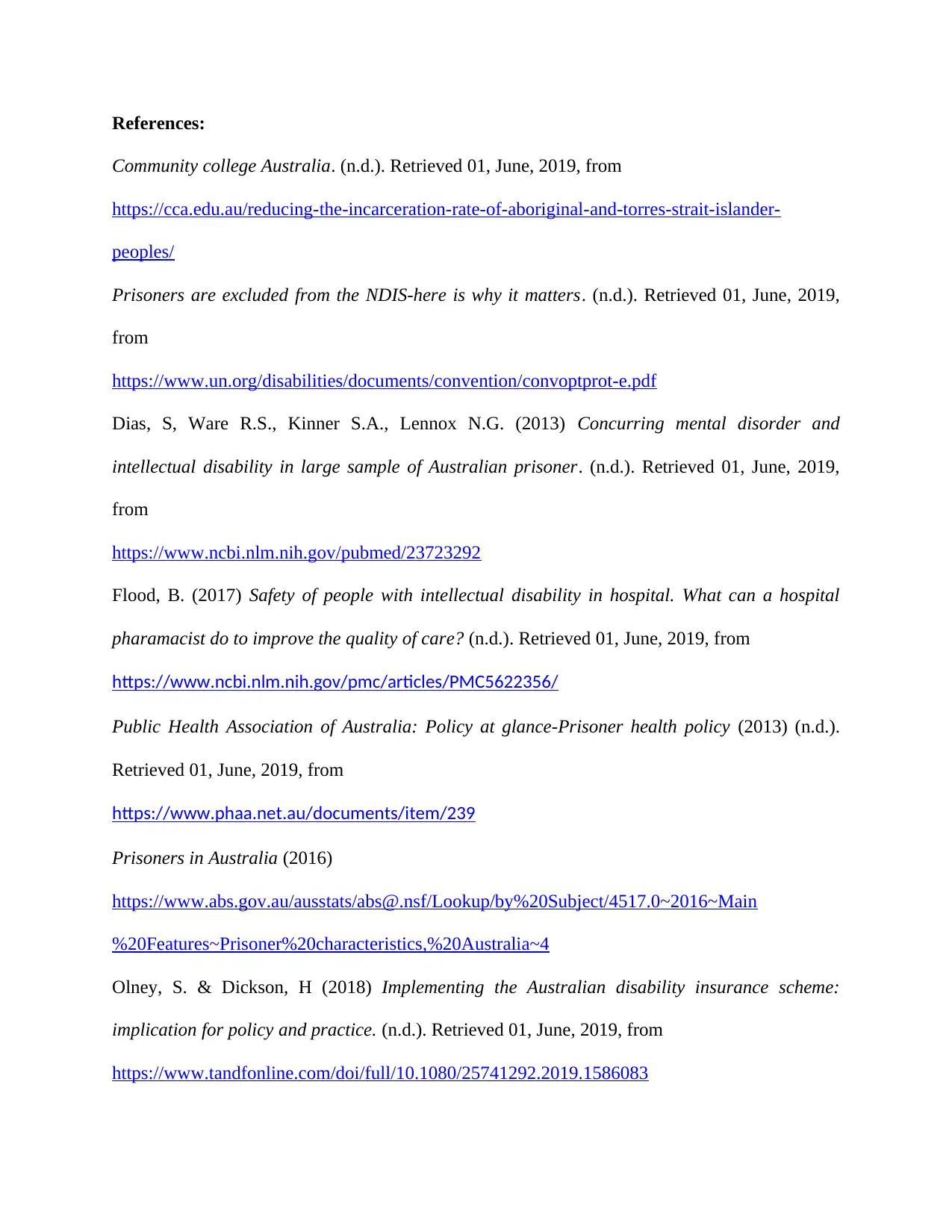
References:
Community college Australia. (n.d.). Retrieved 01, June, 2019, from
https://cca.edu.au/reducing-the-incarceration-rate-of-aboriginal-and-torres-strait-islander-
peoples/
Prisoners are excluded from the NDIS-here is why it matters. (n.d.). Retrieved 01, June, 2019,
from
https://www.un.org/disabilities/documents/convention/convoptprot-e.pdf
Dias, S, Ware R.S., Kinner S.A., Lennox N.G. (2013) Concurring mental disorder and
intellectual disability in large sample of Australian prisoner. (n.d.). Retrieved 01, June, 2019,
from
https://www.ncbi.nlm.nih.gov/pubmed/23723292
Flood, B. (2017) Safety of people with intellectual disability in hospital. What can a hospital
pharamacist do to improve the quality of care? (n.d.). Retrieved 01, June, 2019, from
https://www.ncbi.nlm.nih.gov/pmc/articles/PMC5622356/
Public Health Association of Australia: Policy at glance-Prisoner health policy (2013) (n.d.).
Retrieved 01, June, 2019, from
https://www.phaa.net.au/documents/item/239
Prisoners in Australia (2016)
https://www.abs.gov.au/ausstats/abs@.nsf/Lookup/by%20Subject/4517.0~2016~Main
%20Features~Prisoner%20characteristics,%20Australia~4
Olney, S. & Dickson, H (2018) Implementing the Australian disability insurance scheme:
implication for policy and practice. (n.d.). Retrieved 01, June, 2019, from
https://www.tandfonline.com/doi/full/10.1080/25741292.2019.1586083
Community college Australia. (n.d.). Retrieved 01, June, 2019, from
https://cca.edu.au/reducing-the-incarceration-rate-of-aboriginal-and-torres-strait-islander-
peoples/
Prisoners are excluded from the NDIS-here is why it matters. (n.d.). Retrieved 01, June, 2019,
from
https://www.un.org/disabilities/documents/convention/convoptprot-e.pdf
Dias, S, Ware R.S., Kinner S.A., Lennox N.G. (2013) Concurring mental disorder and
intellectual disability in large sample of Australian prisoner. (n.d.). Retrieved 01, June, 2019,
from
https://www.ncbi.nlm.nih.gov/pubmed/23723292
Flood, B. (2017) Safety of people with intellectual disability in hospital. What can a hospital
pharamacist do to improve the quality of care? (n.d.). Retrieved 01, June, 2019, from
https://www.ncbi.nlm.nih.gov/pmc/articles/PMC5622356/
Public Health Association of Australia: Policy at glance-Prisoner health policy (2013) (n.d.).
Retrieved 01, June, 2019, from
https://www.phaa.net.au/documents/item/239
Prisoners in Australia (2016)
https://www.abs.gov.au/ausstats/abs@.nsf/Lookup/by%20Subject/4517.0~2016~Main
%20Features~Prisoner%20characteristics,%20Australia~4
Olney, S. & Dickson, H (2018) Implementing the Australian disability insurance scheme:
implication for policy and practice. (n.d.). Retrieved 01, June, 2019, from
https://www.tandfonline.com/doi/full/10.1080/25741292.2019.1586083
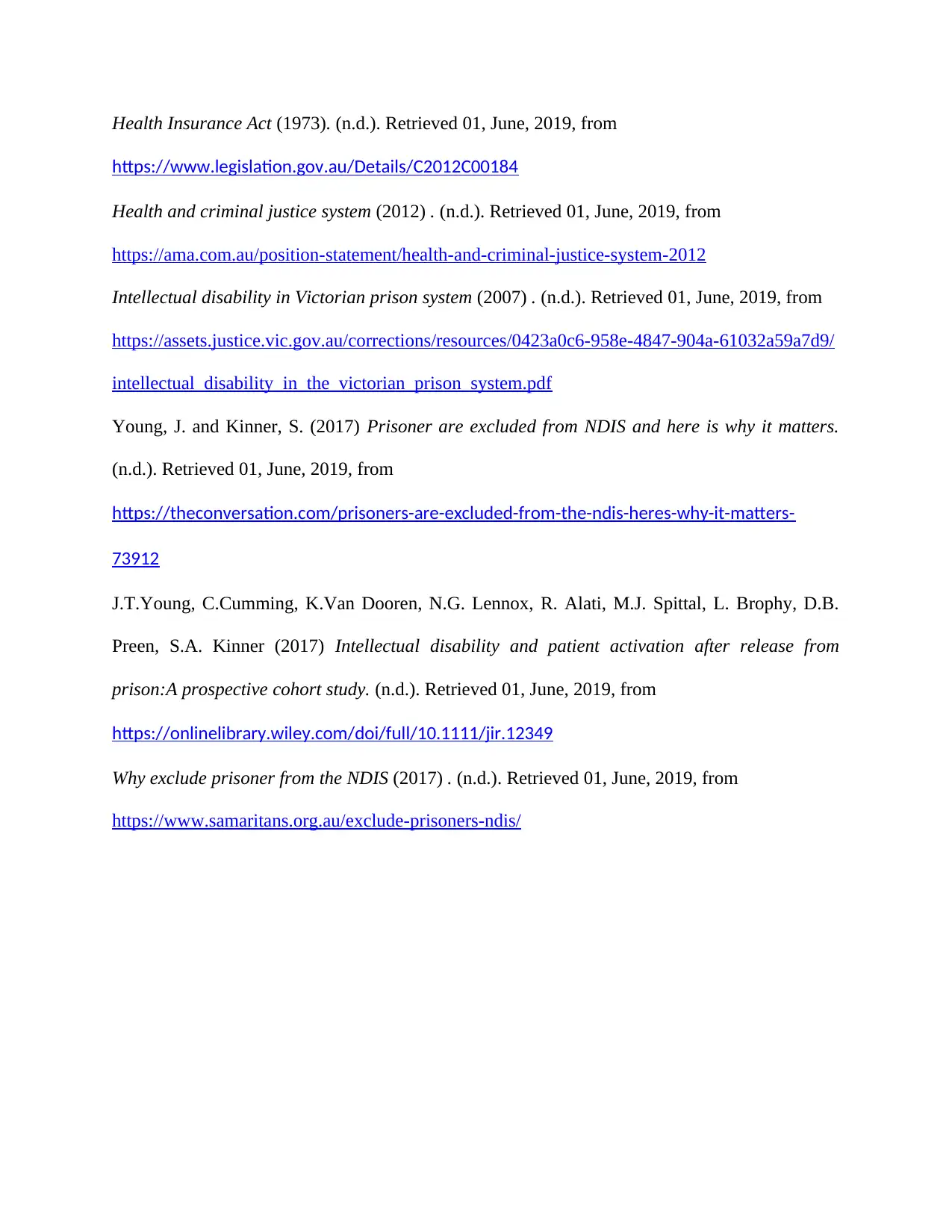
Health Insurance Act (1973). (n.d.). Retrieved 01, June, 2019, from
https://www.legislation.gov.au/Details/C2012C00184
Health and criminal justice system (2012) . (n.d.). Retrieved 01, June, 2019, from
https://ama.com.au/position-statement/health-and-criminal-justice-system-2012
Intellectual disability in Victorian prison system (2007) . (n.d.). Retrieved 01, June, 2019, from
https://assets.justice.vic.gov.au/corrections/resources/0423a0c6-958e-4847-904a-61032a59a7d9/
intellectual_disability_in_the_victorian_prison_system.pdf
Young, J. and Kinner, S. (2017) Prisoner are excluded from NDIS and here is why it matters.
(n.d.). Retrieved 01, June, 2019, from
https://theconversation.com/prisoners-are-excluded-from-the-ndis-heres-why-it-matters-
73912
J.T.Young, C.Cumming, K.Van Dooren, N.G. Lennox, R. Alati, M.J. Spittal, L. Brophy, D.B.
Preen, S.A. Kinner (2017) Intellectual disability and patient activation after release from
prison:A prospective cohort study. (n.d.). Retrieved 01, June, 2019, from
https://onlinelibrary.wiley.com/doi/full/10.1111/jir.12349
Why exclude prisoner from the NDIS (2017) . (n.d.). Retrieved 01, June, 2019, from
https://www.samaritans.org.au/exclude-prisoners-ndis/
https://www.legislation.gov.au/Details/C2012C00184
Health and criminal justice system (2012) . (n.d.). Retrieved 01, June, 2019, from
https://ama.com.au/position-statement/health-and-criminal-justice-system-2012
Intellectual disability in Victorian prison system (2007) . (n.d.). Retrieved 01, June, 2019, from
https://assets.justice.vic.gov.au/corrections/resources/0423a0c6-958e-4847-904a-61032a59a7d9/
intellectual_disability_in_the_victorian_prison_system.pdf
Young, J. and Kinner, S. (2017) Prisoner are excluded from NDIS and here is why it matters.
(n.d.). Retrieved 01, June, 2019, from
https://theconversation.com/prisoners-are-excluded-from-the-ndis-heres-why-it-matters-
73912
J.T.Young, C.Cumming, K.Van Dooren, N.G. Lennox, R. Alati, M.J. Spittal, L. Brophy, D.B.
Preen, S.A. Kinner (2017) Intellectual disability and patient activation after release from
prison:A prospective cohort study. (n.d.). Retrieved 01, June, 2019, from
https://onlinelibrary.wiley.com/doi/full/10.1111/jir.12349
Why exclude prisoner from the NDIS (2017) . (n.d.). Retrieved 01, June, 2019, from
https://www.samaritans.org.au/exclude-prisoners-ndis/
Secure Best Marks with AI Grader
Need help grading? Try our AI Grader for instant feedback on your assignments.

1 out of 11
Related Documents
Your All-in-One AI-Powered Toolkit for Academic Success.
+13062052269
info@desklib.com
Available 24*7 on WhatsApp / Email
![[object Object]](/_next/static/media/star-bottom.7253800d.svg)
Unlock your academic potential
© 2024 | Zucol Services PVT LTD | All rights reserved.




